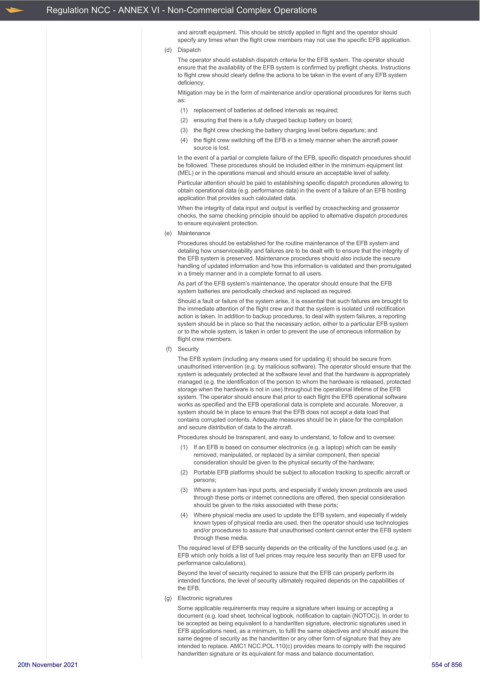Page 554 - UK Air Operations Regulations 201121
P. 554
~
~ Regulation NCC - ANNEX VI - Non-Commercial Complex Operations Centrik
and aircraft equipment. This should be strictly applied in flight and the operator should
specify any times when the flight crew members may not use the specific EFB application.
(d) Dispatch
The operator should establish dispatch criteria for the EFB system. The operator should
ensure that the availability of the EFB system is confirmed by preflight checks. Instructions
to flight crew should clearly define the actions to be taken in the event of any EFB system
deficiency.
Mitigation may be in the form of maintenance and/or operational procedures for items such
as:
(1) replacement of batteries at defined intervals as required;
(2) ensuring that there is a fully charged backup battery on board;
(3) the flight crew checking the battery charging level before departure; and
(4) the flight crew switching off the EFB in a timely manner when the aircraft power
source is lost.
In the event of a partial or complete failure of the EFB, specific dispatch procedures should
be followed. These procedures should be included either in the minimum equipment list
(MEL) or in the operations manual and should ensure an acceptable level of safety.
Particular attention should be paid to establishing specific dispatch procedures allowing to
obtain operational data (e.g. performance data) in the event of a failure of an EFB hosting
application that provides such calculated data.
When the integrity of data input and output is verified by crosschecking and grosserror
checks, the same checking principle should be applied to alternative dispatch procedures
to ensure equivalent protection.
(e) Maintenance
Procedures should be established for the routine maintenance of the EFB system and
detailing how unserviceability and failures are to be dealt with to ensure that the integrity of
the EFB system is preserved. Maintenance procedures should also include the secure
handling of updated information and how this information is validated and then promulgated
in a timely manner and in a complete format to all users.
As part of the EFB system’s maintenance, the operator should ensure that the EFB
system batteries are periodically checked and replaced as required.
Should a fault or failure of the system arise, it is essential that such failures are brought to
the immediate attention of the flight crew and that the system is isolated until rectification
action is taken. In addition to backup procedures, to deal with system failures, a reporting
system should be in place so that the necessary action, either to a particular EFB system
or to the whole system, is taken in order to prevent the use of erroneous information by
flight crew members.
(f) Security
The EFB system (including any means used for updating it) should be secure from
unauthorised intervention (e.g. by malicious software). The operator should ensure that the
system is adequately protected at the software level and that the hardware is appropriately
managed (e.g. the identification of the person to whom the hardware is released, protected
storage when the hardware is not in use) throughout the operational lifetime of the EFB
system. The operator should ensure that prior to each flight the EFB operational software
works as specified and the EFB operational data is complete and accurate. Moreover, a
system should be in place to ensure that the EFB does not accept a data load that
contains corrupted contents. Adequate measures should be in place for the compilation
and secure distribution of data to the aircraft.
Procedures should be transparent, and easy to understand, to follow and to oversee:
(1) If an EFB is based on consumer electronics (e.g. a laptop) which can be easily
removed, manipulated, or replaced by a similar component, then special
consideration should be given to the physical security of the hardware;
(2) Portable EFB platforms should be subject to allocation tracking to specific aircraft or
persons;
(3) Where a system has input ports, and especially if widely known protocols are used
through these ports or internet connections are offered, then special consideration
should be given to the risks associated with these ports;
(4) Where physical media are used to update the EFB system, and especially if widely
known types of physical media are used, then the operator should use technologies
and/or procedures to assure that unauthorised content cannot enter the EFB system
through these media.
The required level of EFB security depends on the criticality of the functions used (e.g. an
EFB which only holds a list of fuel prices may require less security than an EFB used for
performance calculations).
Beyond the level of security required to assure that the EFB can properly perform its
intended functions, the level of security ultimately required depends on the capabilities of
the EFB.
(g) Electronic signatures
Some applicable requirements may require a signature when issuing or accepting a
document (e.g. load sheet, technical logbook, notification to captain (NOTOC)). In order to
be accepted as being equivalent to a handwritten signature, electronic signatures used in
EFB applications need, as a minimum, to fulfil the same objectives and should assure the
same degree of security as the handwritten or any other form of signature that they are
intended to replace. AMC1 NCC.POL.110(c) provides means to comply with the required
handwritten signature or its equivalent for mass and balance documentation.
20th November 2021 554 of 856

